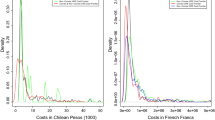Abstract
This paper discusses modeling technical and allocative inefficiencies in both cost minimizing and profit maximizing frameworks with special emphasis on multiple inputs and multiple outputs. Both primal and dual models are considered for this purpose. In the primal approach we use a separable output and input function (the constant elasticity of transformation output function and Cobb-Douglas input function). The dual models assume translog cost or profit functions. Technical inefficiency is assumed to be random in the cross-sectional models, and fixed firm-specific parameter in the panel data models. Allocative inefficiencies are always treated as input-specific parameters. We derive exact relations linking technical inefficiency and allocative inefficiencies to cost and profit when the underlying technology is represented by a flexible functional form such as the translog. It is shown that appending a one-sided homoscedastic error term to model technical inefficiency, or neglecting technical inefficiency altogether in a translog profit tunciton results in model misspecification and inconsistent parameter estimates.
Similar content being viewed by others
References
Aigner, D., C.A.K. Lovell, and P. Schmidt. (1977). “Formulation and Estimation of Stochastic Frontier Production Function Models.” Journal of Econometrics 6 21–37.
Ali, M. and J.C. Flinn. (1989). “Profit Efficiency Among Basmati Rice Producers in Pakistan Punjab.” American Journal of Agricultural Economics 71, 303–310.
Atkinson, S.E. and C. Cornwell. (1994). “Parametric Estimation of Technical and Allocative Inefficiency with Panel Data.” International Economic Review 35, 231–243.
Atkinson, S.E. and R. Halvorsen. (1990). “Tests of Allocative Efficiency in Regulated Multi-Product Firms.” Resources and Energy 12, 65–77.
Atkinson, S. and R. Halvorsen. (1984). “Parametric Efficiency Tests, Economies of Scale, and Input Demand in U.S. Electric Power Generation.” International Economic Review 25, 647–662.
Bauer, P.W. (1985). “An Approach for the Analysis of Multiproduct Technology and Efficiency using Panel Data.” Unpublished Ph.D. Dissertation, Department of Economics, University of North Carolina, Chapel Hill, NC.
Bauer, P.W. and D. Hancock. (1993). “The Efficiency of Federal Reserve in Providing Check Processing Services.” Journal of Banking and Finance 17, 287–311.
Berger, A.N., W.C. Hunter, and S.G. Timme. (1993). “The Efficiency of Financial Institutions: A Review and Preview of Research Past, Present, and Future.” Journal of Banking and Finance 17, 221–249.
Caudill, S.B., J.M. Ford, and D.M. Gropper. (1995). “Frontier Estimation and Firm-Specific Inefficiency Measures in the Presence of Heteroscedasticity.” Journal of Business & Economic Statistics 13, 105–111.
Cornwell, C., P. Schmidt, and R.C. Sickles. (1990). “Production Frontiers with Cross-Sectional and Time-Series Variation in Efficiency Levels.” Journal of Econometrics 46, 185–200
Cummins, J.D. and M.A. Weiss. (1993). “Measuring Cost Efficiency in the Property-Liability Insurance Industry.” Journal of Banking and Finance 17, 463–481.
Eakin, B.K. and T.J. Kniesner. (1988). “Estimating a Non-Minimum Cost Function for Hospitals.” Southern Economic Journal 54, 583–597.
Färe, R. and D. Primont. (1995a). Multi-Output production and Duality: Theory and Applications. Boston: Kluwer Academic Publishers.
Färe, R. and D. Primont. (1995b). “The Opportunity Cost of Duality.” This paper is included in the present volume (vol. 7) nos. 2/3 of Journal of Productivity Analysis.
Ferrier, G.D. and C.A.K. Lovell. (1990). “Measuring Cost Efficiency in Banking: Econometric and Linear Programming Evidence.” Journal of Econometrics 46, 229–245.
Førsund, F. and L. Hjalmarsson. (1987). Analyses of Industrial Structure: A Putty-Clay Approach. Stockholm: The Industrial Institute for Economic and Social Research.
Hollas, D.R. and S.R. Stansell. (1988). “An Examination of the Effects of Ownership Form and Price Efficiency: Proprietary, Cooperative and Municipal Electric Utilities.” Southern Economic Journal 55, 336–350.
Jondrow, J., C.A.K. Lovell, I.S. Materov, and P. Schmidt. (1982). “On the Estimation of Technical Inefficiency in Stochastic Frontier Production Function Model.” Journal of Econometrics 19, 233–238.
Kumbhakar, S.C. (1987). “The Specification of Technical and Allocative Inefficiency in Stochastic Production and Profit Frontiers.” Journal of Econometrics 34, 335–348.
Kumbhakar, S.C. (1991). “The Measurement and Decomposition of Cost-Inefficiency: The Translog Cost System.” Oxford Economic Papers 43, 667–683.
Kumbhakar, S.C. and A. Bhattacharyya. (1992). “Price Distortions and Resource-Use Efficiency in Indian Agriculture: A Restricted Profit Function Approach.” Review of Economics and Statistics 74, 231–239.
Kumbhakar, S.C. (1992). “Allocative Distortions, Technical Progress, and Input Demand in U.S. Airlines: 1970–1984.” International Economic Review 33, 723–737.
Lau, L.J. (1972). “Profit Functions of Technologies with Multiple Inputs and Outputs.” Review of Economics and Statistics 54, 281–289.
Lovell, C.A.K. and R.C. Sickles. (1983). “Testing Efficiency Hypothesis in Joint Production: A Parametric Approach.” Review of Economics and Statistics 65, 51–58.
Mester, L. (1993). “Efficiency in the Savings and Loan Industry.” Journal of Banking and Finance 17, 267–286.
Powell, A.A. and F.H.G. Gruen. (1968). “The Constant Elasticity of Substitution and Linear Supply System.” International Economic Review 9, 315–328.
Schmidt, P. (1984). “An Error Structure for System of Translog Cost and Share Equations.” Econometrics Workshop Paper 8309, Michigan State University.
Schmidt, P. and C.A.K. Lovell. (1979). “Estimating Tecnical and Allocative Inefficiency Relative to Stochastic Production and Cost Frontiers.” Journal of Econometrics 9, 343–366.
Schmidt, P. and R.C. Sickles. (1984). “Production Frontiers and Panel Data.” Journal of Business & Economic Statistics 4, 367–374.
Sickles, R.C., D. Good, and R.L. Johnson. (1986). “Allocative Distortions and the Regulatory Transition of the U.S. Airline Industry.” Journal of Econometrics 33, 143–163.
Toda, Y. (1976). “Estimation of a Cost Function When the Cost is Not Minimum: The Case of Soviet Manufacturing Industries, 1958–1971.” Review of Economics and Statistics 58, 259–268.
Author information
Authors and Affiliations
Rights and permissions
About this article
Cite this article
Kumbhakar, S.C. Efficiency measurement with multiple outputs and multiple inputs. J Prod Anal 7, 225–255 (1996). https://doi.org/10.1007/BF00157043
Issue Date:
DOI: https://doi.org/10.1007/BF00157043




